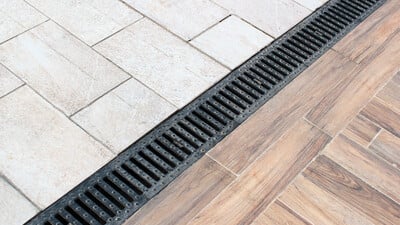If your driveway, patio, or paved area frequently suffers from pooling water during heavy rain, a channel drainage system could be the solution you’re looking for. These systems are specifically designed to collect surface water and guide it safely away from areas prone to flooding, protecting your property, minimising slip risks and preserving your landscaping or hard surfacing.
Whether you’re tackling a DIY installation at home or specifying drainage for a commercial site, understanding the basics of channel drainage can help you choose the most suitable solution for your needs. In this guide, we’ll walk through how channel drainage works, what it’s made of, and how to pick the right type and load class.
A Drain by Any Other Name…
Before we begin, let’s clear up one common cause of confusion. If you’ve already searched for channel drains, you may have encountered a bewildering array of terms: ACO drain, linear drain, trench drain and channel drain. These are all essentially the same thing – ACO drain is a brand name that has become a generic term - long, narrow drains that collect and redirect surface water. To avoid confusion, we will call it channel drain in this article.
How Channel Drainage Works
Channel drainage is a system that collects water along a narrow surface channel and moves it away through an outlet pipe. These channels are typically positioned in low-lying areas such as across driveways or at the edge of patios where water naturally collects.
A metal or plastic grate covers the channel, allowing water to enter while keeping out leaves, litter and other debris that could cause blockages. Once inside the channel, water is guided by gravity toward an outlet, which typically connects to an underground drainage system.
Although channel drains can be installed completely horizontally, a slight slope – typically around 5mm per metre – is usually recommended. This gentle gradient helps to encourage flow and prevent standing water in the channel. Bear in mind, however, that a steeper gradient can affect water attenuation and sediment flow.
The Components of a Channel Drainage System
A typical channel drainage system is made of a few core components, each playing a crucial role in ensuring effective water management.
The main body of the channel is a long, narrow unit that forms the basis of the system. It’s designed to be laid flush with the surrounding surface and is manufactured from various materials including concrete, polymer and high-strength plastic, depending on where it is to be used. These channels are modular, meaning they can be connected in lengths to suit the required drainage run.
A grating covers the channel; this is essential for both safety and function. The grate allows surface water to pass into the channel while preventing it from becoming a trip hazard and keeping larger debris such as leaves and litter from entering and causing blockages. Grates can be made from a range of materials, including plastic for lighter domestic use and galvanised or ductile iron for areas that see heavier traffic.
To seal the system and connect it to your drainage outlet, you’ll usually need end caps and outlet fittings. End caps close off any open ends of the drainage run, while the outlet allows the water collected in the channel to flow into an underground drain. Some systems also include a trash box – an intermediate chamber that collects sediment and larger particles before the water is discharged, helping to reduce the risk of clogging further down the line.
If your project involves bends or multiple branches, additional fittings such as junctions and angle connectors are available to help the system follow your layout, allowing for a continuous and integrated design across the entire surface.
Choosing Between Slot Drains and Grated Channel Drains
When it comes to selecting the style of drainage, two main types dominate the market: slot channel drains and grated channel drains. Both serve the same purpose but differ in appearance, performance and maintenance requirements.
Slot drains are designed to be as discreet as possible. Instead of having a visible grate on top, they have a narrow slit – often just a few millimetres wide – running along the surface. This makes them a popular choice for paved areas where aesthetics matter such as patios, courtyards or public walkways. Their minimal profile also makes them heel-safe, reducing the risk of trips and making them more accessible. However, because the opening is so narrow, slot drains have a more limited capacity and are not ideal for areas expecting large volumes of surface water or heavy debris.
Grated channel drains, on the other hand, are more visible but offer greater performance and versatility. They consist of a removable metal or plastic grating that sits on top of the channel, allowing a larger volume of water to flow through quickly. The removable nature of the grate makes it easier to clean and maintain, as debris can be accessed and removed without dismantling the whole system. These drains are ideal for driveways, loading bays, and car parks – anywhere that might see frequent or heavy rainfall combined with vehicle traffic. However, the exposed grating can be a minor trip hazard, and the system may require more frequent maintenance if exposed to high levels of dirt or leaves.
Channel Drain Loading Classes
Choosing the right channel drain isn’t just about style; it’s also about making sure the system can handle the physical demands of its location. That’s where loading classes are relevant. Each classification indicates the maximum weight and stress a channel drain can safely withstand.
A15
For purely pedestrian areas, such as garden paths, patios or landscaped areas, a channel drain rated at A15 is generally sufficient. This is designed for light loads and is often made from lightweight materials such as polypropylene or uPVC.
B125
If the area will see vehicle access, such as a residential driveway, then a B125 loading class is more appropriate. These drains can handle the weight of cars and small vans, providing a good balance between durability and affordability.
C250 – E600
For commercial environments—such as service yards, delivery bays, or roads—a higher class is needed. C250-rated channel drains are built to withstand constant pressure from heavier vehicles such as trucks and HGVs. In more extreme cases, such as airports or industrial zones where forklifts or lorries operate, even stronger ratings like D400 or E600 are required. These typically feature reinforced concrete bodies and heavy-duty cast iron grates.
It’s vital to choose the correct load class for your application. Under-specifying the load class can lead to cracking, warping, or even catastrophic failure of the drainage system.
Channel Material Options
The performance and longevity of a channel drainage system also depend heavily on the materials used in its construction. The channel body can be made from one of several substances, each offering distinct benefits depending on the environment.
Plastic Channels
Plastic channel bodies, often made from polypropylene or similar polymers, are light and easy to handle. This makes them ideal for DIY installations or low-traffic areas like garden paths or patios. They’re also typically less expensive, which can be useful when working with a tight budget.
Concrete & Polymer Concrete Channels
For areas where durability is key, concrete or polymer concrete channels provide extra strength and rigidity. These are well-suited to areas with occasional or regular vehicle traffic and tend to have a longer lifespan. The grates, meanwhile, are available in a range of materials.
Galvanised Steel & Ductile Iron Channels
Galvanised steel offers a good compromise between cost and durability, while ductile iron is preferred for heavy-duty applications due to its exceptional strength and resistance to wear.
Grating Material Options
Channel drain gratings are available in a range of materials, each suited to different environments based on their strength, corrosion resistance, and visual appeal.
Plastic Gratings
Often made from polypropylene or PVC, these are lightweight and cost-effective. These are best suited to domestic settings such as patios, driveways for light vehicles, or pedestrian walkways. While plastic is easy to install and resistant to rust, it lacks the strength for areas with frequent heavy traffic.
Galvanised Steel Gratings
These offer greater strength and durability and are commonly used in light commercial areas, private driveways with occasional heavy vehicle use, or public pedestrian spaces. The galvanisation process helps protect the steel from rust, although over time, especially in coastal or chemically exposed environments, it may still show signs of corrosion.
Ductile Iron Gratings
This is the strongest, most robust option. Often specified for high-traffic zones such as car parks, loading bays, industrial estates and roads, ductile iron withstands heavy axle loads and resists deformation under pressure. Many models also feature anti-slip finishes or bolt-down fixings for added security in traffic areas.
Stainless Steel Gratings
This is the preferred option where aesthetics and corrosion resistance are priorities, such as in architectural projects, leisure facilities, swimming pool edges and food processing areas. Stainless steel resists staining and is easy to clean, but it is typically more expensive and not always suited for vehicular traffic unless specifically rated.
Other Practical Considerations
When designing or selecting your channel drainage system, it’s important to think beyond just flow rates and materials. For instance, the environment in which the system will operate plays a big role in determining its maintenance needs and performance over time.
If your property is surrounded by trees or loose ground, for example, the system is likely to encounter high levels of debris such as leaves, twigs, or gravel. In these cases, it’s often worth including a trash box with a sediment trap to capture larger particles before they enter your drainage system. This reduces the likelihood of blockages and makes ongoing maintenance much easier.
Appearance is another key factor. In settings where visual harmony matters. In landscaped gardens or paved courtyards, discreet slot drains are often preferred because they blend more seamlessly into their surroundings. However, in more functional spaces like driveways or loading areas, the robust performance of a grated channel may outweigh aesthetic concerns.
Ease of maintenance should also influence your choice. While slot drains have fewer parts to clean, grated drains give you easier access to the inside of the channel. If you expect to need regular cleaning, opting for a design with removable grates might save time and effort in the long run.
Explore Drainfast’s Channel Drainage Solutions
Whether you're managing stormwater on a domestic driveway or specifying heavy-duty drainage for a commercial yard, channel drains offer a versatile and reliable solution. By understanding how these systems work and choosing the right type for your setting, you can ensure better drainage performance, fewer maintenance issues, and a safer, more resilient surface.
Ready to find the right product for your needs? Browse Drainfast’s full range of channel drainage systems, or contact us for friendly, professional advice and high-quality products delivered rapidly nationwide from our well-stocked depots.

Written by
Bob Stone
Technical Sales
Heading up our Technical Estimating Department, Bob is our in-house quantity surveyor.

